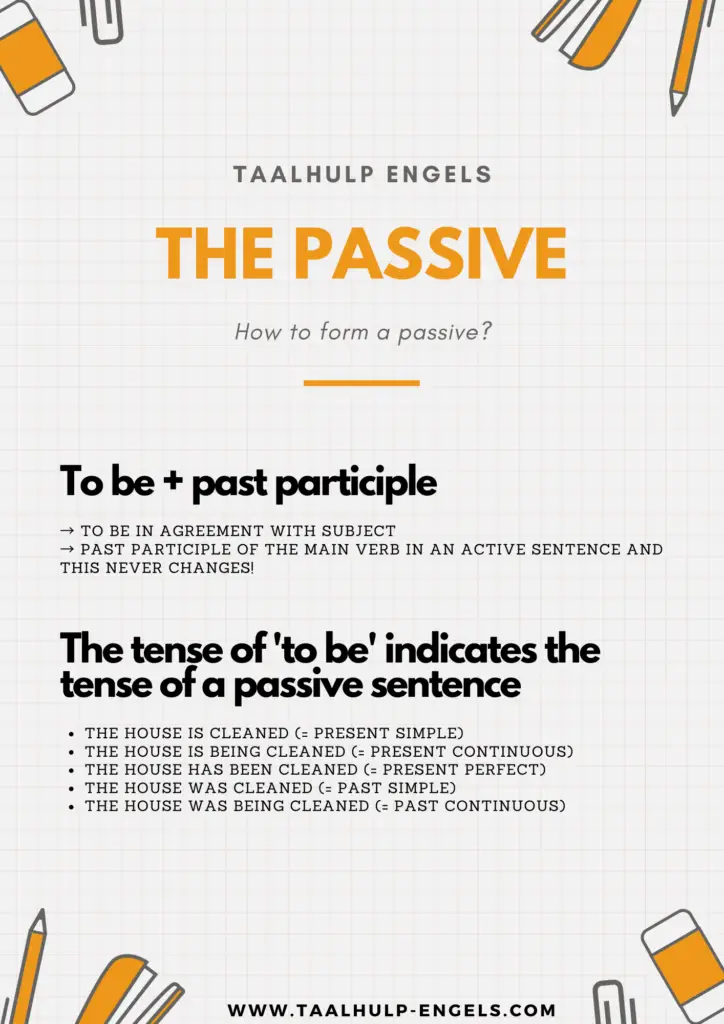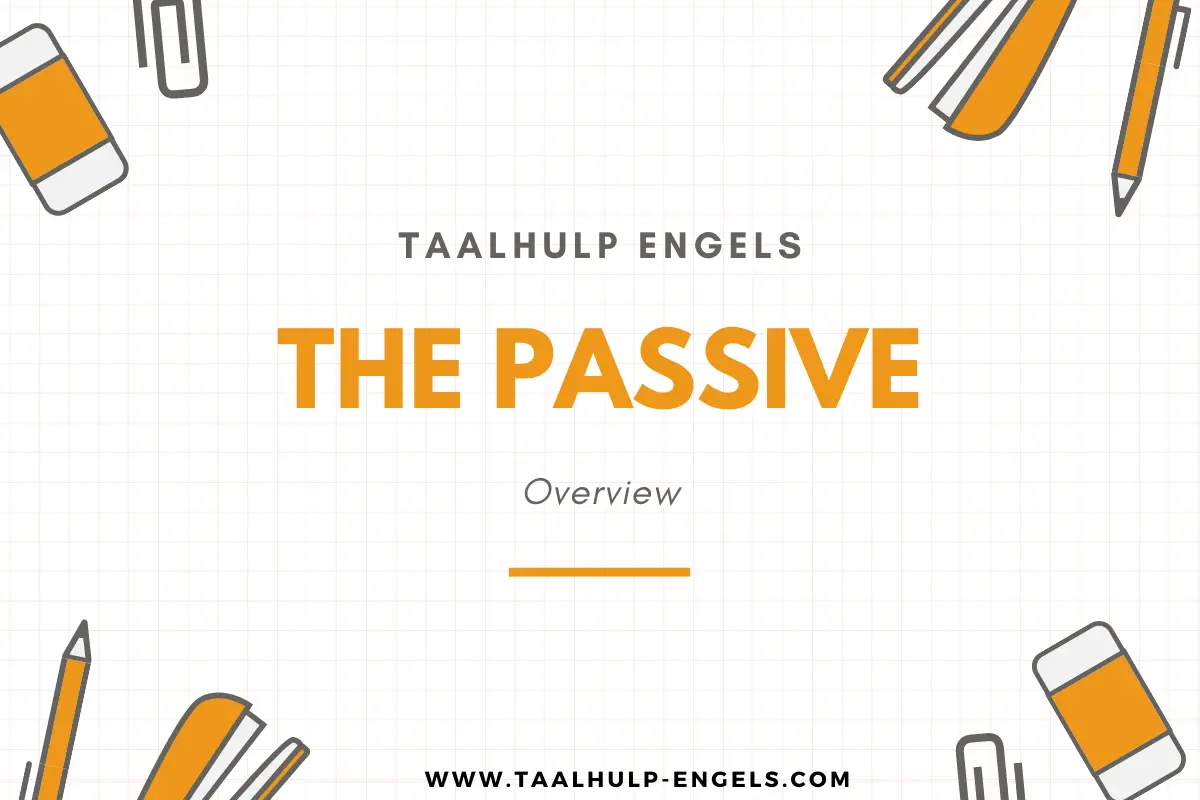In English, you could say: ‘My brother is eating a big red apple’, but you could also say: ‘The big red apple is being eaten by my brother’. These sentences give the same information as you clearly know what is happening. The big difference between them is that a different structure is used. The first one is an active sentence, while the second one is a passive sentence.
On this page, you have a detailed overview of what a passive construction is in English, when you use it and how you form it.

The passive
In addition to active sentences, which make up the majority of sentences we use every day, there are also passive sentences in English.
The passive is used to express who or what experiences something, instead of actively doing it. Take a look at the example:
- My brother is eating an apple: active because my brother is actively doing something.
- The big red apple is being eaten by my brother: passive because the apple is being eaten by someone else and is not doing something.
How to recognise a passive sentence
Sometimes it is difficult to know whether you are dealing with a passive or active sentence. The easiest way to be sure of this is to see whether the subject is actively doing something or not.
- The subject is doing something: active sentence
- The subject is not doing something and is experiencing an action: passive sentence
If you put ‘by zombies’ at the end of a sentence, it’s easy to see the difference. If these zombies are doing the action of the sentence, you are dealing with a passive sentence. Take a look at the examples below:
| My car is stolen. |
| My car is stolen by zombies. |
The second sentence shows that the zombies are doing the action (stealing the car).
| I always steal a car when I have no money. |
| I always steal a car when I have no money by zombies. |
The zombies are not doing the action in the second sentence because the subject (=I) is the one who is stealing cars. This means these sentences are active sentences. If you put ‘by zombies’ at the end of the sentence, it sounds weird and does not really have a meaning anymore.
Use of a passive construction
As already mentioned above, you use the passive when you want to say someone or something is experiencing something instead of actively doing it. There is a clear difference between the sentences below.
| I am stealing a car right now. |
| A car is being stolen right now. |
The first sentence is active because the subject (I) is doing something: stealing a car. The second sentence is passive because the subject (a car) is experiencing something and doesn’t do anything itself.
It all comes down to the fact that you use this kind of construction in English when you want to focus on what something or someone is experiencing. There are some more examples below.

| An apple is eaten by a bird. |
| A car is hit by a tree. |
| A plan is created. |
| My phone was stolen. |
| His watch is destroyed. |
You can also use this kind of construction when you have no idea who is doing the action of the sentence. Take a look at the example below:
| The apple is eaten by my sister. |
| The apple is eaten. |
Both sentences are correct and give enough information to know what is happening. When using a passive structure, it’s not really necessary to say that it is your sister who is eating the apple. The most important thing is that the reader knows that the apple is being eaten. ‘By my sister’ is extra information and not necessary to understand what is happening.
Form of the passive
To form the passive in English, you always need two parts:
to be + past participle
The verb ‘to be’ and the subject of a passive sentence need to be in agreement. For the past participle, you need to use the past participle of the main verb in the active sentence.
| The apple is eaten |
| The car was stolen. |
| The book is read. |
The underlined part is the verb ‘to be’ and the word in bold is the past participle
The past participle never changes. ‘To be’ changes, depending on the subject and the tense of a sentence. The tense of ‘to be’ indicates the tense of a passive sentence.

Going from active to passive
If you want to use a passive construction in English, you need to be able to change an active sentence into a passive one. You have an overview of the different steps below. Take a look at the following example:
I always eat an apple.
This sentence is active and in order to make it passive, you need to change some things. The first thing you need to do is find the subject. In this sentence, ‘I’ is the subject because ‘I’ eats the apple.
I always eat an apple.
The next step is looking for the main verb and the tense of this verb. In this particular sentence, ‘eat’ is the verb and the tense of this verb is the present simple.
I always eat an apple.
The third thing you need to do is find the (direct) object. This means you need to find out who experiences the action. In this particular sentence, the direct object is ‘an apple’ because this apple is being eaten.
I always eat an apple.
Once you have done all the steps, it’s fairly easy to form a passive sentence. The (direct) object from an active sentence becomes the subject in a passive sentence. Next, you need the past participle of the main verb in the active sentence. Then, you need to find out the tense of this verb (in the active sentence). In this particular example, it’s the present simple (eat). The verb ‘to be’ needs to be in the same tense in the passive sentence. Finally, you can put the subject of the active sentence at the end of a passive sentence. Don’t forget to put ‘by’ in front of the subject.
An apple is always eaten (by me).
- An apple: a direct object in the active sentence becomes the subject in the passive sentence.
- is: you put ‘to be’ in the tense of the active sentence (present simple in this example).
- eaten: this is the past participle of the main verb in the active sentence.
- (by me): the subject from the active sentence can be put at the end of the passive sentence but is not necessary.
Tenses in a passive sentence
As mentioned above, the verb ‘to be’ tells you which tense you have in a passive sentence. The past participle is always the same, so we don’t really pay attention to that when deciding which tense it is.
If an active sentence is in the past simple, you need to put ‘to be’ in the past simple in the passive sentence. If an active sentence is in the present perfect, you need to put ‘to be’ in the present perfect as well. Take a look at the overview of the different tenses in the passive below:
| Tense | Active | Passive |
|---|---|---|
| Present simple | I clean the house. | The house is cleaned. |
| Present continuous | I am cleaning the house. | The house is being cleaned. |
| Present perfect | I have cleaned the house. | The house has been cleaned. |
| Past simple | I cleaned the house. | The house was cleaned. |
| Past continuous | I was cleaning the house. | The house was being cleaned. |
| Past perfect | I had cleaned the house. | The house had been cleaned. |
| Future simple | I will clean the house. | The house will be cleaned. |
| Going-to future | I am going to clean the house. | The house is going to be cleaned. |


Exercises
- Multiple Choice Exercise 1
- Multiple Choice Exercise 2
- Multiple Choice Exercise 3
- Multiple Choice Exercise 4
- Multiple Choice Exercise 5
- Exercise 1
- Exercise 2
- Exercise 3
- Exercise 4
- Exercise 5


